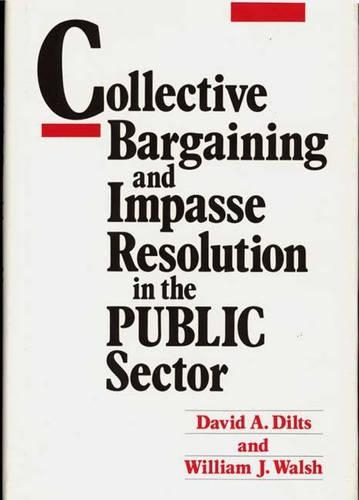
Collective Bargaining and Impasse Resolution in Public Sector
(Hardback)
Publishing Details
Collective Bargaining and Impasse Resolution in Public Sector
By (Author) David A. Dilts
By (author) William J. Walsh
Bloomsbury Publishing PLC
Praeger Publishers Inc
14th October 1988
United States
Classifications
Tertiary Education
Non Fiction
331.89041350000973
Physical Properties
Hardback
253
Description
Although much has been written concerning labor relations and collective bargaining in the private sector, negotiators working in public sector employer-employee relations have been handicapped by the paucity of practical information relating to the specific demands of their field. Responding to an evident need, Dilts and Walsh supply detailed guidelines for the practicing negotiator and at the same time enlarge our knowledge of an area that is of increasing significance to academics and professionals alike. They provide in-depth explanations of the principles and practices of fact-finding, interest arbitration, mediation, contract negotiation, and impasse resolution procedures for the public sector, with particular emphasis on labor relations problems confronting state and local governments. The first four chapters outline the basics of public sector collective bargaining. Labor law, contract negotiations, impasse creation, negotiation strategies and tactics, and relevant economic and behavioral issues are discussed. The steps typically found in statutory impasse resolution procedures are examined. The authors next focus on mediation techniques, the situations in which they most often prove successful, and the procedures used in fact-finding and interest arbitration hearings. They explain the differing decisional standards employed by arbitrators and fact-finders in cases involving economic issues and language issues. Other topics covered are factors affecting impasse resolution, the effects of impasse resolution on labor relations, guidelines for utilizing fact-finding reports and interest arbitration awards, and experimental impasse resolution techniques that have been applied in the public sector. The most comprehensive, practitioner-oriented work in its field, this volume will be of value to professionals, e.g., union and management officials and representatives, and academics concerned with public sector labor-management relations, labor law, and human resources management.
Reviews
The volume is sensibly organized, proceeding from a general examination of the legal and strategic contexts of collective bargaining, to a general discussion of impasses, to specific coverage of resolution techniques. There is much useful material for practitioners. Both authors are experienced in public-sector labor-management relations (the senior author is also active academically in the field). The appendixes contain examples of fact-finding and arbitration awards. Recommended for professional and graduate collections. * Choice *
The book is intended to address the specific needs of negotiators in the public sector: union and management officials and representatives, human resources management, labor lawyers, and academics concerned with public-sector labor-management relations. It outlines the basics of public sector collective bargaining and examines the steps typically found in statutory impasse resolution procedures. Also discussed are mediation techniques and the situations in which they are most often successful, the procedures used in fact-finding hearings and interest arbitration hearings, standards for decisions used by arbitrators, and several facets of impasse resolution. * Legal Information Alert *
[T]his text might serve as supplementary for its public sector character, to a longer course dealing with collective bargaining. Or it might be used at a community college level with more specific supplements attuned to the applicable state statutes. * Labor Studies Journal *
Author Bio
David A. Dilts is professor of business administration at Indiana University, Purdue-Fort Wayne. William J. Walsh earned his PhD from Indiana University.
